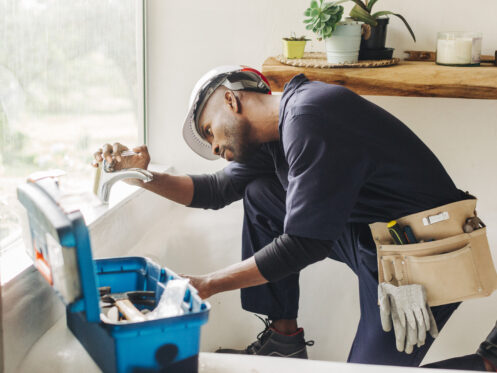Like all major industries, the plumbing world is changing rapidly today. From smart plumbing technologies to changing water usage habits, homeowners have a lot to keep up with. How do you know which projects are worth doing, though? If you want to avoid the hype and focus on practical solutions, pay attention to the following five plumbing trends in 2025.
1. Smart Plumbing Technologies
Smart home technology is transforming how we interact with our home’s plumbing systems. Wireless sensors installed in or near pipes, water heaters and appliances monitor water flow and detect potential leaks in real time. These tiny devices work like digital watchdogs, sending instant alerts to homeowners’ phones if they detect unusual water flow levels or pressure changes.
If an extreme leak or failure occurs, some smart systems can even access valves to automatically shut off water flow. This significantly reduces the risk that you might come home to a flood because of a leak that happened while you were at work or on vacation. Leak detection systems use advanced math to understand normal household water usage patterns, too. When something goes wrong, such as a constantly running toilet, the system can intervene to prevent waste and avert possible water damage.
Some smart plumbing systems track water usage by fixture. They show exactly how much water each shower, sink and appliance uses throughout the day. Data analytics play a crucial role in these new systems. By collecting information about water flow, temperature and usage patterns, these systems identify inefficiencies. The best smart plumbing technologies even perform predictive maintenance. Such smart technologies can calculate the decline of an aging system and tell you when it might be time to have our plumbers install a new dishwasher or water heater.
2. Water Conservation and Recycling
Water-saving systems are increasingly popular for home use. Low-flow showerheads and toilets now work great while using less water. For example, a new showerhead can cut water use by almost half in a typical household that uses an older design. Likewise, systems like aerators for sink faucets can reduce water usage in a household.
Homeowners can start reusing water from sinks and washing machines to water their yards and gardens. The process is known as gray-water recycling. Gray water in this case refers to leftover water from activities that ensure it isn’t great for drinking but that doesn’t completely foul the water, such as doing the dishes. Pipes can redirect water that would normally go down the drain into a tank for use in other activities. Many gardeners like to reuse gray water for their plants, for example.
3. Sustainable Materials
The plumbing industry is working on new ways to reuse or manufacture pipes and fixtures using sustainable methods. Recycled copper gives old metal a second life, turning scrap from industry and demolished buildings into brand-new piping. Materials and fixtures from sources like buildings and industry are popular choices for use in bathroom and kitchen remodels, too. This means less waste in landfills and fewer raw materials needed to make plumbing supplies.
Plant-based manufacturing processes for making new pipes are changing how we think about plumbing materials. Made from renewable resources like beets, corn and sugar, these materials are more biodegradable at the end of their service life than traditional plastic pipes. The best of the available modern bio-materials are easily strong enough to handle water pressure for residential applications. Consequently, homeowners don’t have to choose between plumbing performance and environmental sustainability.
4. Better Appliances and Plumbing Components
Modern washing machines and dishwashers have become remarkable examples of engineering efficiency and mechanical performance. Today’s appliances use advanced technology to minimize water and energy consumption while delivering superior cleaning. Washing machines now integrate sensors that precisely measure load size and fabric type, adjusting water volume and temperature with impressive accuracy. High-efficiency front-loading washing machines represent a significant leap forward. Many of these models use nearly 50% less water than traditional top-loading designs, spinning clothes in a tumbling motion that requires minimal liquid to clean effectively.
Dishwashers have similarly transformed. Modern units employ sophisticated spray arm designs and targeted water jets that clean dishes more thoroughly while using significantly less water. Sensors inside these appliances can detect food particle density, adjusting water pressure and volume in real time. The most advanced models consume around three gallons per cycle, a dramatic reduction from machines just a decade ago that frequently used 10 to 15 gallons. Especially if you don’t currently have a dishwasher or are using an older model, we strongly recommend upgrading.
Tankless water heaters make hot water available by only heating water when needed. These systems eliminate the energy waste associated with traditional storage tanks that have to keep reheating water to provide a ready supply. Compact units use advanced heat exchangers to rapidly warm water as it passes through, reducing standby energy consumption significantly. Tankless models only activate when a hot water line opens, providing on-demand heating with a high level of precision.
Water softeners have also undergone technological improvements that reduce water and salt consumption. Modern salt-free water conditioning systems can prevent mineral buildup without the traditional salt-based process. These systems eliminate the need for frequent backwashing, which otherwise wastes significant amounts of water during the softening cycle. Some advanced salt-based models can reduce salt usage by up to 75% compared to conventional water softeners. They also minimize water waste during the treatment process by cycling less often.
5. Improved Water Quality
Homeowners care more about indoor water quality today than ever before. Adding water filters, UV purifiers or acid neutralizers makes a big difference. Filters catch dirt and chlorine. UV purifiers kill germs. Acid neutralizers fix water acidity to improve taste, and they also protect pipes and appliances.
Plumbing materials also affect water quality. Safer options like PEX or stainless steel keep harmful chemicals out of your water. Older materials like lead or outdated PVC can leach dangerous substances into the water. Removing these components makes your water safer, and it also will bring your home’s plumbing system in line with local codes and industry standards.
Contact Us Today
Pilgrim Plumbing, Inc. is a family-oriented contractor that has been in business since 2015. We tackle residential and commercial plumbing jobs for folks in Norwell, Hingham, Rockland, Whitman and Pembroke, MA and the surrounding areas. Our plumbers have the know-how needed to handle installation, repairs, upgrades and maintenance. We also offer emergency service.
We are a Rinnai PRO Dealer. Our team is highly familiar with systems from major brands like Kohler, A.O. Smith, Simmons, Delta, Viessmann and IBC. You can trust us to work on water heaters, gas lines and fittings and water softeners. We also welcome plumbing jobs attached to kitchen and bathroom remodeling efforts. Check our specials page online to find ways to save on your planned work. Qualified buyers may want to take advantage of financing to make payments at great interest rates, too. If you’re excited about any of the big trends in plumbing in 2025, contact Pilgrim Plumbing, Inc. today to get your project rolling.


